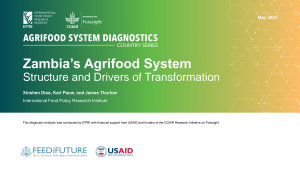Zambia’s agrifood system structure and drivers of transformation
Diao, Xinshen · Ellis, Mia · Pauw, Karl · Thurlow, James
Jul 2023 · Intl Food Policy Res Inst
Ebook
22
Pages
family_home
Eligible
info
reportRatings and reviews aren’t verified Learn More
About this ebook
Zambia experienced modest economic growth of 4.8 percent per year between 2010 and 2019 (ZamStats 2020). Most growth occurred in the earlier part of the decade. After world commodity prices fell in 2014, the GDP growth rate slowed to an annual rate of 3.1 percent (for 2014–2019), which is below the country’s population growth rate. The global COVID-19 pandemic further damaged the economy and GDP declined by 2.8 percent in 2020. The global commodity market disruptions related to the Russia Ukraine war that started in 2022 and the global recession in 2023 are expected to further harm Zambia’s economy (Arndt et al. 2023; Diao and Thurlow 2023). Zambia’s projected GDP growth rate is 3.9 percent for 2023 and 4.1 percent for 2024 (World Bank 2023). Its economy relies heavily on exports of copper and other minerals. While mining is a large sector in total GDP, it creates few jobs in the country. Agriculture remains important in employment, accounting for near 40 percent of jobs. In this brief, we unpack the historical and projected economic growth trajectory further to better understand the role of agriculture as well as the broader agrifood system (AFS) in the performance and transformation of the economy of Zambia.
Rate this ebook
Tell us what you think.
Reading information
Smartphones and tablets
Install the Google Play Books app for Android and iPad/iPhone. It syncs automatically with your account and allows you to read online or offline wherever you are.
Laptops and computers
You can listen to audiobooks purchased on Google Play using your computer's web browser.
eReaders and other devices
To read on e-ink devices like Kobo eReaders, you'll need to download a file and transfer it to your device. Follow the detailed Help Center instructions to transfer the files to supported eReaders.








